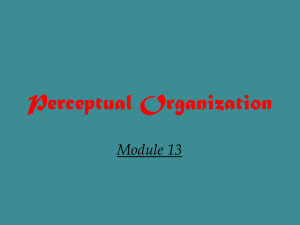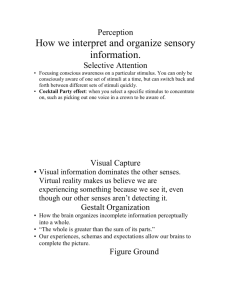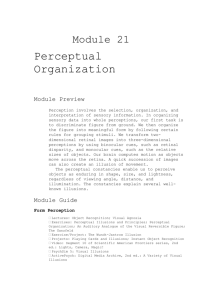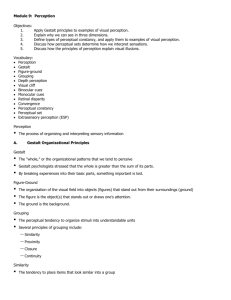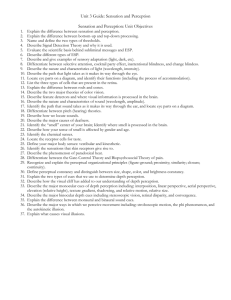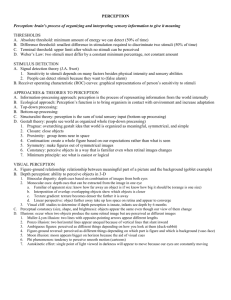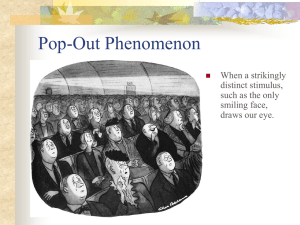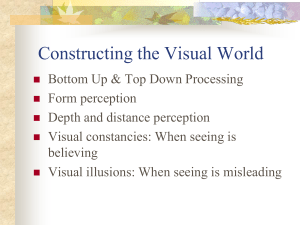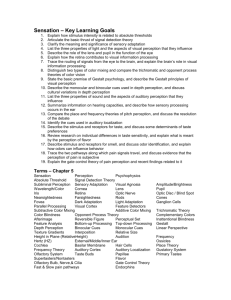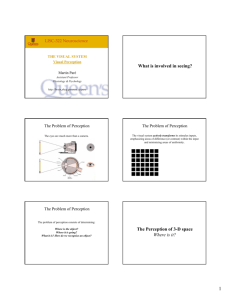Psychology: Introduction to Perception
advertisement
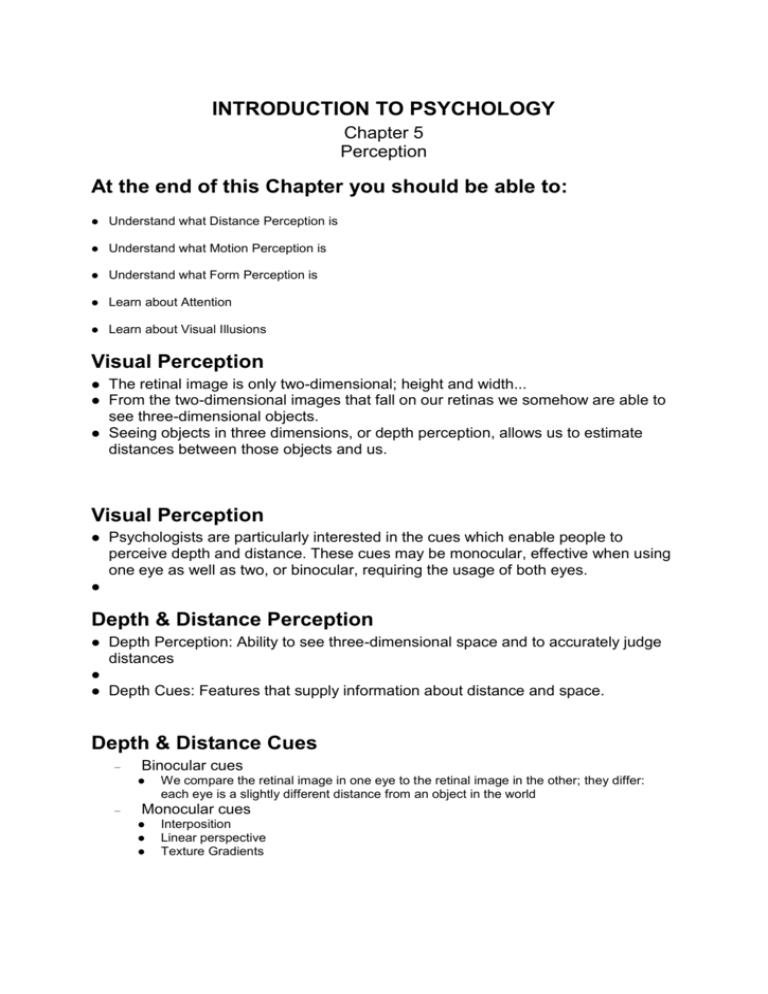
INTRODUCTION TO PSYCHOLOGY Chapter 5 Perception At the end of this Chapter you should be able to: Understand what Distance Perception is Understand what Motion Perception is Understand what Form Perception is Learn about Attention Learn about Visual Illusions Visual Perception The retinal image is only two-dimensional; height and width... From the two-dimensional images that fall on our retinas we somehow are able to see three-dimensional objects. Seeing objects in three dimensions, or depth perception, allows us to estimate distances between those objects and us. Visual Perception Psychologists are particularly interested in the cues which enable people to perceive depth and distance. These cues may be monocular, effective when using one eye as well as two, or binocular, requiring the usage of both eyes. Depth & Distance Perception Depth Perception: Ability to see three-dimensional space and to accurately judge distances Depth Cues: Features that supply information about distance and space. Depth & Distance Cues – Binocular cues – We compare the retinal image in one eye to the retinal image in the other; they differ: each eye is a slightly different distance from an object in the world Monocular cues Interposition Linear perspective Texture Gradients Monocular Cues: Interposition : When one object partly blocks your view of another, you perceive the partially blocked object as farther away Monocular Cues: Linear Perspective : Parallel lines that are known to be the same distance apart appear to grow closer together, or converge, as they recede into the distance Monocular Cues: Texture Gradient: The texture of objects tend to become smoother as the object gets farther away, suggesting that more detailed textured objects are closer. Monocular Cues: Relative Size: Larger objects are perceived as being closer to the viewer, and smaller objects as being farther away Monocular Cues: Light and Shadow: (A) Eight circular objects. To most viewers, the one in the middle looks concave, indented, whereas other seven look as if they are bulging out. (B) The same figure rotated 180 degrees. Now, the middle object looks convex, while others seem concave. The reason is the location of the shadow. If the shadow is at the bottom, the object looks convex, if the shadow is at the top, the the object looks concave. Monocular Cues: Motion Parallax When you ride in a moving vehicle and look at the side window, the objects you see appear outside move in opposite direction Objects seem to be moving in different speeds-the ones that are closer to you seem to move faster, whereas objects far behind seem to move slower Perceptual Constancy The tendency to perceive objects as maintaining stable properties (e.g., size, shape, brightness, and color) despite differences in distance, viewing angle, and lighting Size Constancy: Size constancy refers to our ability to see objects as maintaining the same size even when our distance from them makes things appear larger or smaller. Shape constancy: Perceiving objects as having a stable or unchanging shape regardless of changes in the retinal image resulting from differences in viewing angle Motion Perception Perception of an event -motion- rather than an object Motion tells us what the object is doing. • • Apparent movement Eye movement Apparent motion When intervals between images occur at correct timing (not too far apart in time) we perceive motion This principle used to create ‘motion’ from stills Apparent motion In movies, when still pictures are put together, it produces the sensation of movement for the viewer (audience). Even though there is no ACTUAL movement. We do not only detect motion but we also interpret it. Form Perception – We can find differences among features effortlessly – Finding a circle in a field of squares is easy regardless of how many squares there are We need more than features or a simple checklist to be able to recognize objects What about the variability in objects that we see? The same animal but the features look different. So how can we classify all of them as a giraffe? We recognize giraffes as being giraffes whether we see them from the side, or the front, or close up, or from far away. Do we actually pay attention to every detail (feature)? We only interpret crucial information. We don’t have time in the real-world to pay attention to every little detail. Otherwise we cannot survive! Form Perception Detecting object features (parts) The importance of organization Perceptual parsing Separating the figure from the ground Organization’s role in perception Features: some we ignore, some we attend to How do we decide whether to ignore or attend? We interpret some features as being part of the object, other features as irrelevant How do we group together features that belong with each other? Gestalt Psychology The German word "Gestalt" roughly means to "whole" or "form" “The whole is greater than the sum of its parts.” In order to interpret what we receive through our senses, we attempt to organize this information into certain groups. – Sense of shape: derived from the whole, not the sum of its parts Gestalt principles organization Perceptual parsing: – – Segregating the “scene” into its constituent objects The first step to organizing Gestalt principles of organization: Issues of figure/ground Similarity Proximity Good continuation – “subjective contours” The classical approach to perception Emphasis on the active, constructive role of the perceiver, who routinely: – – – Resolves ambiguous figures Determines identity of objects based on contextual clues and previous knowledge Determines identity of objects based on contextual clues Illusions: How could we make such mistakes? Cues sometimes cause an over-estimate or under-estimate; Slight over/under interpretations can cause us to misinterpret the information we receive Usually: – – – perceptions are accurate are based on relevant experience reflect the world we live in Perceptual selection: Attention What starts the synchrony? One possible mechanisms: ATTENTION Selective control of orientation – Selective looking Difficult when target represents multiple, rather than a single, feature Other modalities Hearing: much in common with vision – – – Sounds must be parsed; what goes with what? Contexts must be noted: “Kiss this guy” versus “Kiss the sky” have identical sounds involved, but different contexts Attention crucial determinant of what is heard Other modalities less rich for human beings than are vision and hearing Some final thoughts: Seeing, knowing, and the perceiver’s active role Perception is not knowledge Knowledge and perception are mutually influenced, but are not the same thing: the perceiver and the knower are distinct in many instances Web Links for Optical Illusions Mueller-Lyer Illusion Brightness Illusion Checker-Shadow Illusion

